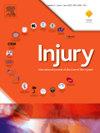Treatment and outcome after hip fracture for patients on oral anticoagulation
IF 2.2
3区 医学
Q3 CRITICAL CARE MEDICINE
Injury-International Journal of the Care of the Injured
Pub Date : 2025-02-01
DOI:10.1016/j.injury.2024.112072
引用次数: 0
Abstract
Aims
An increasing number of patients with hip fracture are taking oral anticoagulation medication including direct oral anticoagulants (DOAC). The management of these patients regarding the timing of surgery and occurrence of complications remains contentious. The aim of this study was to compare treatment and outcomes for hip fracture patients taking anticoagulation.
Methods
Data from a consecutive series of 3,707 hip fracture patients admitted to a single centre was collected over a seven-year period.
Results
The proportion of patients taking warfarin fell slightly over the study period (6.1 % to 4.7 %) whilst the proportion taking DOAC increased greatly (1.4 % to 11.4 %). Patients on oral anticoagulation were slight older (mean age 83 years for warfarin, 85 years for DOAC versus 80 years for those not on anticoagulation), more likely to have atrial fibrillation, less likely to take anti-platelet medication and less likely to have spinal anaesthesia. Patients taking oral anticoagulant had an increased delay to theatre (mean hours admission to theatre 37.9 for warfarin, 39.5 for DOAC, 31.1 for no anticoagulation). There was no difference in the number of patients transfused, wound complications, post-operative haemoglobin or 30 -day mortality between groups.
Conclusion
Current policies on the timing of surgery and anticoagulation are safe.
髋部骨折后口服抗凝治疗的疗效分析。
目的:越来越多的髋部骨折患者正在服用口服抗凝药物,包括直接口服抗凝剂(DOAC)。这些患者的手术时机和并发症的发生管理仍然存在争议。本研究的目的是比较髋部骨折患者使用抗凝治疗的治疗和结果。方法:在7年的时间里,从一个中心连续收集了3707例髋部骨折患者的数据。结果:服用华法林的患者比例在研究期间略有下降(6.1%至4.7%),而服用DOAC的患者比例则大幅上升(1.4%至11.4%)。口服抗凝治疗的患者年龄稍大(华法林组平均年龄83岁,DOAC组平均年龄85岁,未使用抗凝治疗的患者平均年龄80岁),更容易发生心房颤动,服用抗血小板药物的可能性更小,脊柱麻醉的可能性更小。服用口服抗凝剂的患者入院时间延迟增加(华法林组平均入院时间37.9小时,DOAC组平均入院时间39.5小时,未服用抗凝剂组平均入院时间31.1小时)。两组患者输血数量、伤口并发症、术后血红蛋白和30天死亡率均无差异。结论:目前的手术时机和抗凝政策是安全的。
本文章由计算机程序翻译,如有差异,请以英文原文为准。
求助全文
约1分钟内获得全文
求助全文
来源期刊
CiteScore
4.00
自引率
8.00%
发文量
699
审稿时长
96 days
期刊介绍:
Injury was founded in 1969 and is an international journal dealing with all aspects of trauma care and accident surgery. Our primary aim is to facilitate the exchange of ideas, techniques and information among all members of the trauma team.

 求助内容:
求助内容: 应助结果提醒方式:
应助结果提醒方式:


